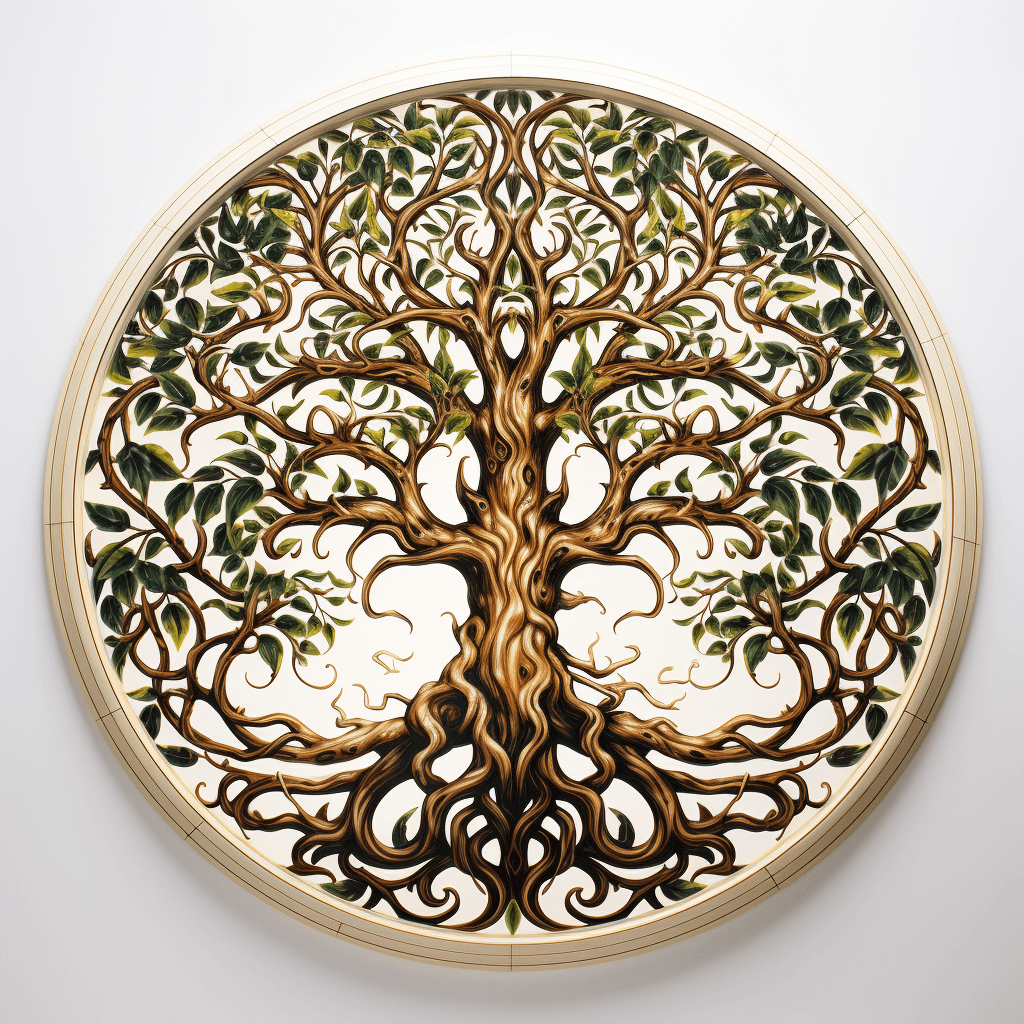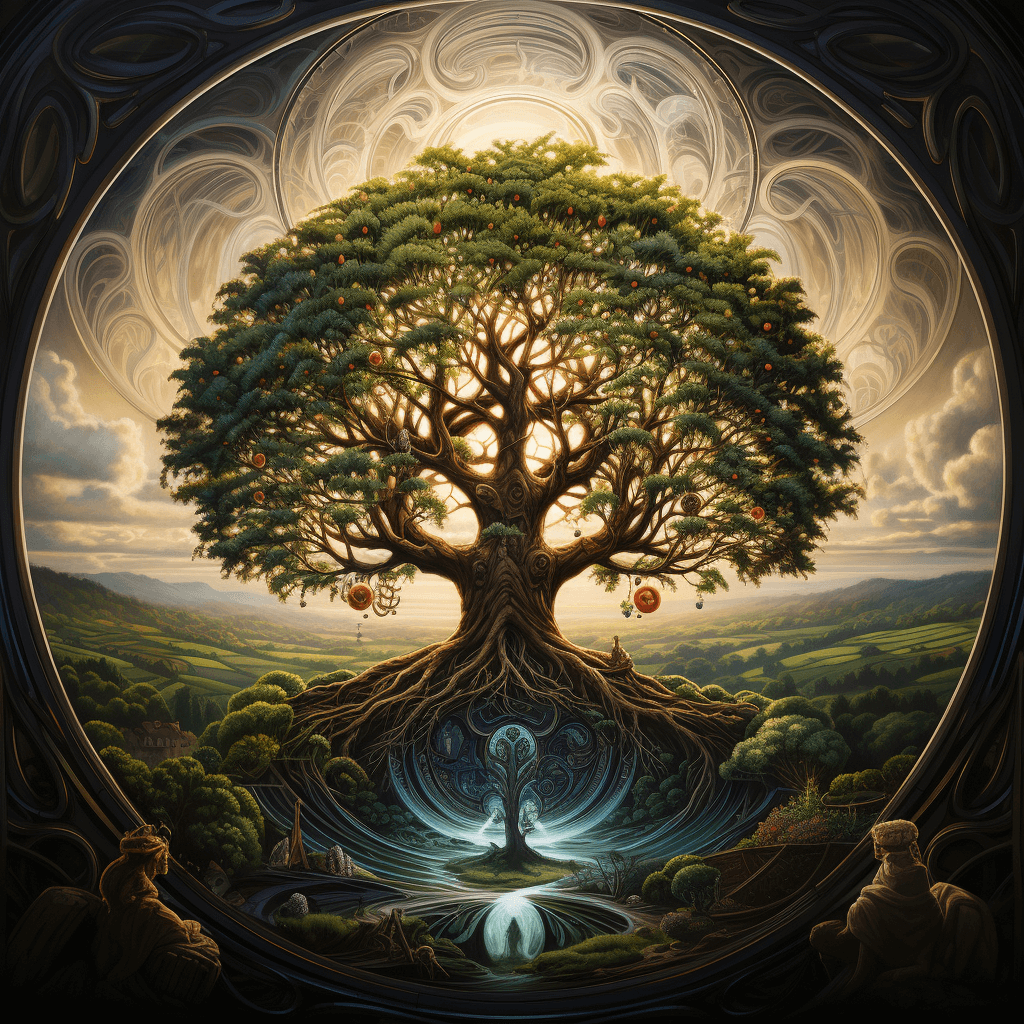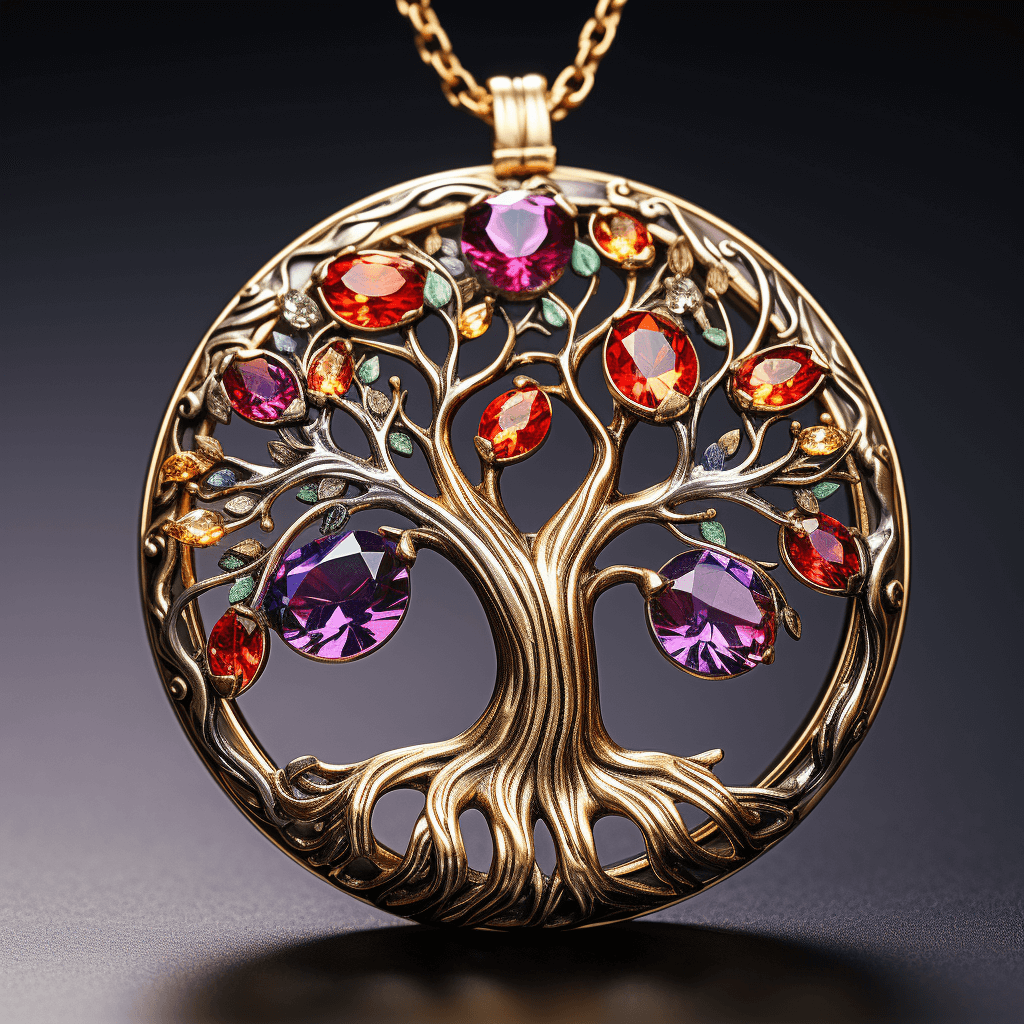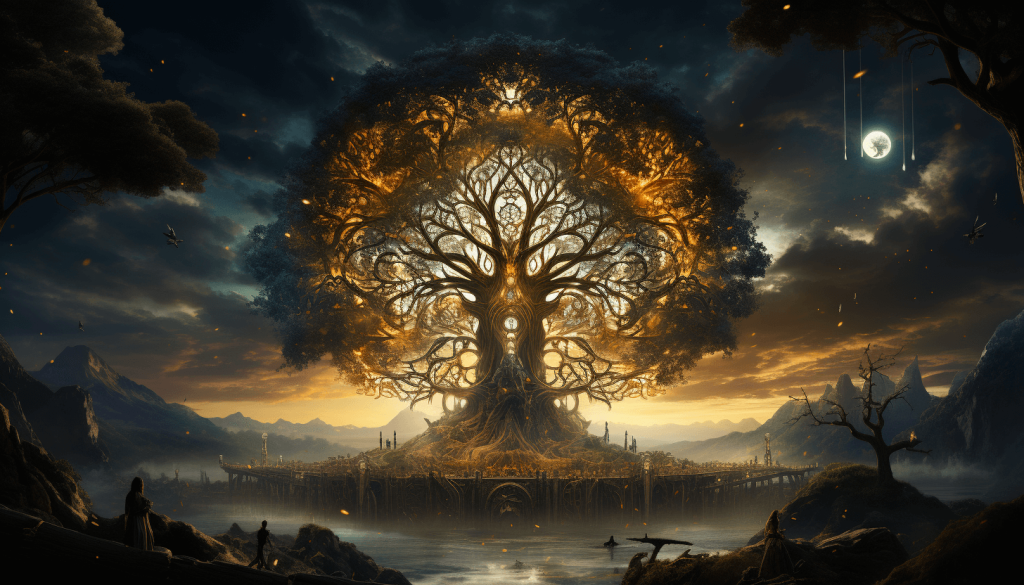Introduction: The Tree of Life, A Universal Symbol
The Tree of Life is a widespread theme or archetype in many of the world’s mythologies, religious traditions, and philosophies. It speaks of an interconnected cosmos, where everything relates to everything else, symbolizing unity and the cyclic nature of life. The Tree of Life is seen as a sacred symbol in many cultures, representing the interconnection of all life on our planet.
Though it may bear different names in different cultures, the Tree of Life carries a thread of commonality – it represents the interconnectedness of life, the universe, and our place within it. The Tree of Life serves as a potent symbol and metaphor for the way of all life and the cyclical nature of existence.
The Tree of Life is a potent, universal symbol found in many spiritual and philosophical traditions. It represents the interconnectedness of all life, the cycle of birth, growth, death, and rebirth, and personal evolution. Embodying unity, growth, and resilience, the Tree of Life serves as a reminder of our deep-rooted connection with the Earth and the cosmos, encouraging us to grow with strength and wisdom.
Tree of Life in Various Religions: Similarities and Differences
| Religion | Interpretation |
|---|---|
| Christianity | In Christianity, the Tree of Life is mentioned in the Genesis and Revelations of the Bible. It stands in the Garden of Eden as a symbol of eternal life. |
| Judaism | In Judaism, the Tree of Life, or ‘Etz haChayim’ in Hebrew, is a metaphor for the Torah itself, symbolizing wisdom, guidance, and adherence to God’s laws. |
| Buddhism | In Buddhism, the Tree of Life is the Bodhi Tree under which Gautama Buddha attained enlightenment. It symbolizes wisdom, understanding, and the ultimate escape from the cycle of rebirth. |
| Hinduism | In Hinduism, the Ashvattha tree, or the Banyan tree, is considered the Tree of Life. It represents the eternal and divine nature of the soul that outlasts the temporary body. |
| Norse Mythology | In Norse mythology, Yggdrasil is the Tree of Life. It is an immense ash tree that is center to the cosmos and considered very holy. |
While these interpretations may differ in their details, the Tree of Life’s overarching theme of interconnection, unity, and the cycle of life remains constant across these religions and mythologies. This shared symbolism underscores its universal relevance and resonance.
The Tree of Life in Christianity: Symbolism and Biblical References

In Christian tradition, the Tree of Life is one of the most profound symbols found in the scriptures. The symbol first appears in Genesis, where it is planted by God in the Garden of Eden. “And out of the ground made the Lord God to grow every tree that is pleasant to the sight, and good for food; the tree of life also in the midst of the garden, and the tree of knowledge of good and evil” (Genesis 2:9). It represents immortality, eternal life, and the interconnection of all life.
The Tree of Life is again referenced in the book of Revelation, symbolizing a new beginning and eternal life. “To him that overcometh will I give to eat of the tree of life, which is in the midst of the paradise of God” (Revelation 2:7). These biblical references underline the belief that those who accept salvation will be blessed with eternal life.
The Tree of Life in Buddhism: The Bodhi Tree and Enlightenment
In Buddhism, the Tree of Life is synonymous with the Bodhi Tree under which Siddhartha Gautama, who later became known as the Buddha, attained enlightenment. It symbolizes awakening, understanding, and the end of ignorance. The Buddha’s enlightenment is the most pivotal event in Buddhist mythology, marking the moment when a person can rise above the cycle of life, death, and rebirth, achieving Nirvana.
The Bodhi Tree, a large and very old Sacred Fig tree (Ficus religiosa), is located in Bodh Gaya, India. It is an important pilgrimage site for Buddhists. In Buddhist symbolism, the tree’s wide, spreading canopy signifies the vastness of the Buddha’s enlightenment, while its deep roots mirror the depth of his insight into the nature of life and existence.
The Tree of Life in Norse Mythology: Yggdrasil and the Nine Worlds
In Norse mythology, the Tree of Life is represented by Yggdrasil, an immense and central cosmic tree. Its roots and branches extend into various realms, and it plays a significant role in Norse cosmology. Yggdrasil connects the nine worlds in Norse mythology, including Asgard, the realm of the gods, and Midgard, the world of humanity.
Yggdrasil is often depicted as an ash tree, known for its longevity and resilience. It’s seen as a symbol of the cyclical nature of life, death, and rebirth. Creatures like the eagle, representing the sky and the heavens, and Nidhogg, a serpent symbolizing the underworld, reside in Yggdrasil, reinforcing the concept of the tree as a link between various planes of existence.
The Tree of Life in Kabbalah: Understanding the Sefirot
In Kabbalah, a school of thought in Jewish mysticism, the Tree of Life is a diagram called the Sefirot. The Sefirot is a complex system of ten spiritual properties through which Ein Sof (The Infinite) reveals Itself and continuously creates both the physical realm and the chain of higher metaphysical realms.
The ten Sefirot include, in descending order, Keter (the crown), Chokhmah (wisdom), Binah (understanding), Chesed (mercy or kindness), Gevurah (strength), Tiferet (beauty), Netzach (eternity), Hod (glory), Yesod (foundation) and Malkuth (sovereignty). The Sefirot are considered revelations of the Creator’s will, and they represent the different aspects of God.
These ten spheres are arranged in a specific pattern, forming the Tree of Life symbol, with its interconnected lines suggesting the interplay among these divine attributes, and the process by which the Universe came into being. It is also used as a guide to understand the nature of God and the manner in which He created the world out of nothingness.
The Tree of Life in Native American Traditions

In Native American traditions, the Tree of Life has a significant meaning as it symbolizes the interconnection of all life on our planet. It represents the belief in the natural balance and harmony of the earth and all living things.
The depiction and interpretations of the Tree of Life can vary among different tribes. For instance, the Iroquois believe that the Tree of Life is a symbol of the great sky woman, who fell down to earth and began the human race. For the Hopi, the tree symbolizes a connection between the earth and the sky, with roots extending into the underworld and branches reaching towards the heavens.
In various tribes, the Tree of Life is also represented in beadwork, pottery, jewelry, and other forms of art, carrying the inherent values of love, harmony, balance, and connection.
Interpreting the Symbolism of The Tree of Life
The Tree of Life as a symbol is rich and multifaceted, found in numerous cultures and religious traditions around the world. While the specific interpretations may vary, the core themes remain similar across different contexts.
- Connection: The Tree of Life often symbolizes the interconnectedness of everything in the universe. It shows that all forms of life are connected in a cyclical process of life, death, and rebirth.
- Growth and Transformation: The tree undergoes changes with the seasons, yet remains standing. This can symbolize personal growth and the ability to withstand challenges.
- Immortality and Resurrection: Many trees live for hundreds or even thousands of years, symbolizing longevity and immortality. Additionally, trees “resurrect” every spring, further linking them with themes of renewal and rebirth.
- Fertility: Many trees bear fruit, symbolizing abundance and fertility. In some cultures, the Tree of Life is associated with the divine feminine, or motherhood.
These interpretations provide a broad overview of the Tree of Life’s symbolism, and individual meanings can vary greatly depending on the cultural, religious, or personal context.
The Tree of Life in Art and Literature
The Tree of Life motif has been a recurrent theme in various forms of art and literature across cultures and eras. The symbol’s profound meanings and its intricate design have made it a beloved subject for artists and writers.
In visual art, the Tree of Life is often depicted as a majestic, sprawling tree, sometimes with various creatures nestled in its branches, signifying the interconnectedness of all life. Some of the most famous examples include the mosaics found in the ancient Roman Empire, the medieval tapestries, and the intricate carvings on Hindu temples. The theme is also popular in modern art, for example, in the works of famed artists like Gustav Klimt.
In literature, the Tree of Life has often been used as a metaphor for spiritual growth, the interconnectedness of all living beings, or the journey towards enlightenment. Authors from Dante Alighieri to J.R.R. Tolkien have incorporated this potent symbol into their works.
The Tree of Life in Modern Pop Culture
The Tree of Life has not only found its place in religious texts, mythologies, art, and literature, but also in modern popular culture. From film and television to video games and comic books, the symbol continues to be explored and interpreted in new and innovative ways.
In cinema, movies such as “The Tree of Life” by Terrence Malick and “Avatar” by James Cameron have used the Tree of Life as a central motif to explore themes of life, death, and the interconnectedness of all beings. The symbol also appears in TV series like “Game of Thrones,” where the weirwood trees serve a role akin to the Tree of Life.
In the world of video games, the Tree of Life is often depicted as a source of power or a portal to other worlds. Examples include the Yggdrasil tree in “God of War” or the Great Deku Tree in “The Legend of Zelda” series.
In all these contexts, the Tree of Life serves as a powerful symbol that continues to captivate audiences and inspire creators.
Using the Tree of Life Symbol for Personal Growth and Spirituality
The Tree of Life is more than just a beautiful symbol; it’s also a tool for introspection and personal growth. Many people incorporate this symbol into their spiritual or mindfulness practices, viewing it as a representation of their journey of growth and transformation.
In the context of personal growth, the tree’s roots symbolize the grounding energy that keeps us stable and centered, the trunk represents our resilience and strength, and the branches and leaves symbolize our aspirations and growth. As we navigate life’s challenges, the Tree of Life can serve as a reminder of our potential for resilience, growth, and transformation.
Some people also use the Tree of Life in meditation or visualization exercises, imagining themselves as a tree and focusing on the aspects of grounding, strength, and growth. This can be a powerful practice to promote mindfulness, stability, and personal transformation.
The Tree of Life in Jewelry and Decor: Meaning and Styling Tips

Jewelry and decor pieces featuring the Tree of Life are popular choices for those who appreciate the symbol’s rich meanings and aesthetic appeal. These items can serve as a daily reminder of the symbol’s profound significance and bring a touch of spiritual or mystical flair to one’s style.
Tree of Life jewelry—such as pendants, earrings, and bracelets—is often crafted from precious metals and may be adorned with gemstones. When choosing a piece of Tree of Life jewelry, you might consider the symbolic meanings of different gemstones. For example, an amethyst Tree of Life pendant could symbolize spiritual growth, while a garnet-studded piece might be associated with grounding energy.
As for decor, Tree of Life wall hangings, tapestries, or sculptures can add a touch of meaningful elegance to your home. Depending on the style of your decor, you might opt for a minimalist metal wall art piece, a colorful tapestry, or a rustic wooden carving.
Whether you’re drawn to the Tree of Life for its aesthetic appeal, spiritual significance, or both, incorporating this symbol into your style can add a layer of depth and meaning to your everyday life.
How to Draw Your Own Tree of Life: A Step-By-Step Guide
Creating your own Tree of Life drawing can be a meditative and rewarding process, allowing you to explore and express your own interpretations of this profound symbol. Here’s a simple step-by-step guide to get you started:
- Draw the Roots: Start by drawing a few wavy lines at the bottom of your paper to represent the roots of your tree. These should spread out in different directions, symbolizing the grounding energy of the tree.
- Create the Trunk: From the center of the roots, draw a vertical line that widens as it goes up. This is the trunk of your tree, representing stability and strength.
- Add Branches: At the top of the trunk, add some branches. These can be as simple or as intricate as you like. Branches signify growth and reach, so feel free to get creative with their direction and shape.
- Draw Leaves: Finally, add leaves to your branches. You can draw individual leaves, or simply create clusters of them. These represent life and prosperity.
Remember, there’s no right or wrong way to draw your Tree of Life. This is your personal interpretation, and the process itself should be enjoyable and meaningful.
The Tree of Life and Environmental Consciousness
The Tree of Life symbol is also deeply tied to environmental consciousness. As a representation of all life on Earth, it serves as a potent reminder of our connection to the natural world and our responsibility to protect and preserve it.
From a environmental perspective, the tree’s roots remind us of the importance of a healthy, sustainable foundation – the earth. The trunk symbolizes resilience, highlighting the ability of nature to endure and adapt, despite the adversities it faces. The branches and leaves symbolize diversity and interconnectedness, reminding us that every species and ecosystem on our planet plays a crucial role in the web of life.
As such, the Tree of Life can inspire us to take action in preserving our environment, whether that’s by reducing our carbon footprint, supporting reforestation efforts, or advocating for policies that protect our planet’s biodiversity. Embracing the Tree of Life symbol can be a step towards a more environmentally conscious mindset and lifestyle.
Conclusion: Embracing the Lessons from the Tree of Life
In conclusion, the Tree of Life is a versatile and powerful symbol that has resonated with diverse cultures and religions for millennia. Its meanings are as varied as the traditions from which it originates, yet all carry a universal respect for the interconnectedness of life.
The Tree of Life serves as a profound reminder of our personal growth, resilience, and interconnectedness with the rest of the world. Whether seen through a spiritual lens as a map of the cosmos and the human soul, or viewed as an emblem of environmental consciousness, the Tree of Life’s roots run deep into the human experience.
By embracing the lessons of the Tree of Life, we can cultivate a deeper understanding of our place in the world, recognizing our own potential for growth, resilience, and connection with the world around us. We are all leaves on the same tree, drawing nourishment from the same roots, and in recognizing this, we acknowledge the inherent value of every form of life.
So, whether you wear it as a piece of jewelry, incorporate it into your artwork, or simply reflect on its profound symbolism, the Tree of Life is a symbol that can inspire and guide us through life’s journey. Let us respect its wisdom and allow it to remind us of our role in the grand scheme of the cosmos.
Frequently Asked Questions
What is the biblical meaning of the tree of life?
In the Bible, the Tree of Life is mentioned in the Book of Genesis, Proverbs, and Revelation. It represents eternal life, divine wisdom, and the interconnectedness of all life. The fruit of the tree gives eternal life, implying a connection with God’s immortality.
What does tree of life mean as a gift?
As a gift, the Tree of Life symbolizes strong roots, consistent growth, and unity. It makes a meaningful present for occasions like birthdays, anniversaries, or any milestone event, symbolizing the recipient’s personal growth and the connection to all life forms.
What did Jesus say about the tree of life?
In Revelation 2:7, Jesus said, “Whoever has ears, let them hear what the Spirit says to the churches. To the one who is victorious, I will give the right to eat from the tree of life, which is in the paradise of God.” This suggests that the Tree of Life symbolizes eternal life granted by God.
What is the purpose of the tree of life?
The Tree of Life serves various purposes depending on the cultural or religious context. In general, it symbolizes the interconnectedness of all life, personal growth, and the cycle of life – birth, growth, death, and rebirth. It can also represent a spiritual journey towards enlightenment and immortality.
Is the tree of life a religious symbol?
Yes, the Tree of Life is a significant symbol in many religions, including Christianity, Judaism, Buddhism, and various Indigenous cultures. It is often associated with knowledge, wisdom, the interconnectedness of all life, and in many cases, a connection with the divine or spiritual enlightenment.
What does the tree of life mean in Hebrew?
In Hebrew, the Tree of Life is “Etz Chaim.” In Jewish tradition, it often refers to the Torah, the holy scriptures, symbolizing wisdom, guidance, and the spiritual nourishment that the Torah provides.
Where is the real tree of life?
The “real” Tree of Life is largely a matter of belief and interpretation, as it is a symbolic concept present in many religions and philosophies. However, there’s a 400-year-old tree in Bahrain that’s popularly referred to as the “Tree of Life” due to its survival in an apparently waterless desert.
Does the tree of life still exist?
The Tree of Life, as referenced in religious and philosophical texts, is symbolic and thus does not exist physically. The concept, however, continues to hold significant spiritual, philosophical, and cultural meaning in many societies.
What is the tree of life made of?
The Tree of Life is a symbolic concept and does not physically exist. As such, it isn’t made of any material substance. However, in artworks, jewelry, or other physical depictions, it can be made from a variety of materials such as metal, wood, or even gemstones.

